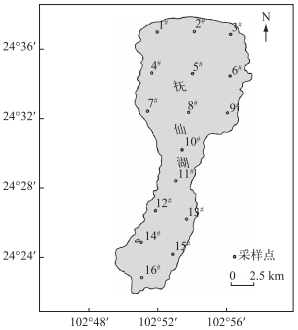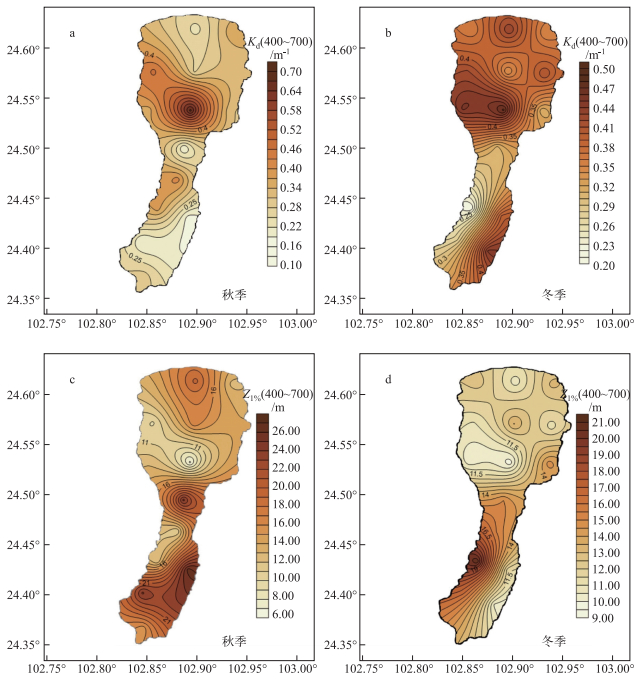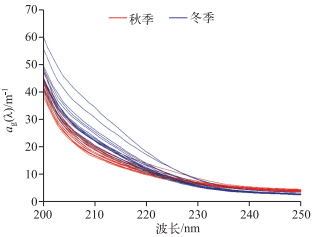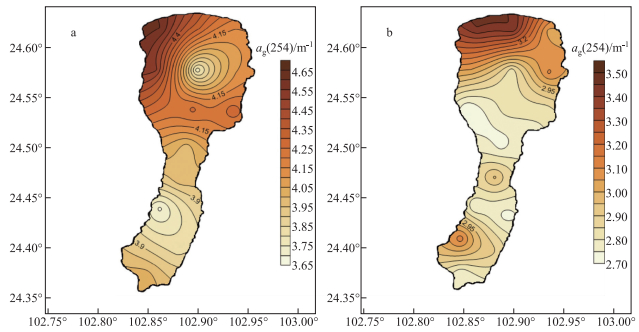(2: 中国科学院南京地理与湖泊研究所湖泊与环境国家重点实验室, 南京 210008)
(3: 中国科学院大学, 北京 100049)
(2: State Key Laboratory of Lake Science and Environment, Nanjing Institute of Geography and Limnology, Chinese Academy of Sciences, Nanjing 210008, P. R. China)
(3: University of Chinese Academy of Sciences, Beijing 100049, P. R. China)
紫外辐射(ultraviolet radiation, UVR)是日光的必有成分,UV-C(200~280 nm)通常被臭氧层和大气层完全吸收,到达地面的主要为UV-B(280~320 nm)和UV-A(320~400 nm);UVR与光合有效辐射(photosynthetically active radiation, PAR, 400~700 nm)共同影响着湖泊生态系统的热力学结构、生物地球化学循环、光合作用与初级生产力、种群动态和群落结构等层面的发展与变化[1-3].光辐射在水体中的传输分布主要受纯水、有色可溶性有机物(chromophoric dissolved organic matter, CDOM)、浮游植物和非色素颗粒物的影响[1];其中,CDOM普遍存在于自然水体,是重要的光化学、光生物学和生物地球化学物质,对UVR有强烈的吸收[1, 4].高海拔清澈型湖泊中,溶解性有机质(含CDOM)、浮游植物对UVR衰减的贡献大[5-8],加之二者含量低,使其光辐射对流域环境的变化更加敏感;同时,海拔高致使所接受的UVR强[9],较深的UVR穿透深度或使其对湖泊生态系统的影响进一步放大.
抚仙湖是高原深水贫营养湖泊的典型代表,主导功能为饮用水源地,保持着良好水质(Ⅰ~Ⅱ类)[10].然而,历史数据已表明,抚仙湖富营养化和有机污染水平及浮游植物生物量有所升高,透明度下降,水质有恶化趋势[11-12],浮游植物功能群[13]、底栖动物[14]和鱼类[15]群落结构等亦已发生变化.鉴于光对湖泊生态过程的驱动作用,要更好地实现对抚仙湖生态环境的保护,对其光学特征的深入了解是难以回避的.目前,涉及抚仙湖光学特征(含CDOM)的研究并不多[16-18],且未涉及时空差异及其影响因子等方面的分析;秋、冬季不仅是太阳辐射与温度变化、湖泊热分层变化的重要时期,还是抚仙湖雨季、旱季的不同代表,亦是浮游植物增殖或衰退的关键时期,以上均可能对CDOM的来源、降解以及湖泊光场等产生重要影响.因此,本文基于新近开展的野外调查,研究了抚仙湖秋、冬两季UV-B、UV-A、PAR的衰减特征及其与CDOM、悬浮物(suspended solids, SS)、浮游植物等的关系,结果既能为抚仙湖积累有关历史数据,又能为基于湖沼学原理的高原清澈型深水湖泊的生态环境保护提供支撑.
1 材料与方法 1.1 抚仙湖概况抚仙湖(24°21′~24°38′N,102°49′~102°57′E),断陷型湖泊,地跨云南省玉溪市澄江、江川、华宁三县,属中亚热带高原半湿润季风气候,湖泊面积216.6 km2,最大水深158.9 m,平均水深95.2 m,是我国第二深内陆淡水湖泊;运行水位1720.8~1722.5 m,蓄水量206.2×108 m3,占云南九大高原湖泊总蓄水量的67.9%,属贫营养湖泊[10].
1.2 样品采集与指标测定在抚仙湖设置16个点位(图 1,1#~9#代表北部,10#~16#代表南部),于2014年10月下旬(秋季)和2015年1月下旬(冬季)开展调查工作.各点位均用PUV-2500水下剖面辐射仪(Biospherical Instruments Inc., USA)测定不同深度不同波长(段)的光强,测定的深度范围为0~3.3 m,再根据指数拟合计算UV-B(305 nm)、UV-A(340 nm)与PAR(400~700 nm)衰减系数(Kd),并计算1%辐射深度(Z1%)[16];用多参数水质监测仪YSI 6600(Yellow Springs Instruments, USA)测定水柱水温(WT)、电导率(EC)、pH和溶解氧(DO),由此计算热分层期的温跃层相关指标[19];与此同时,采集各点位水下0.5 m水样,测定其它相关指标.

|
图 1 抚仙湖采样点位置 Fig.1 Location of sampling sites in Lake Fuxian |
CDOM光谱吸收系数:采用经孔径0.22 μm的Millopore膜过滤的水样在带积分球的UV-2550 PC型分光光度计(SHIMADZU, Japan)下测定200~800 nm波长范围的吸光度,然后进行计算、校正得到各波长的吸收系数[18],以254 nm的吸收系数(ag(254))表征CDOM丰度[20];ag(λ)/Kd(λ)为λ波长时CDOM吸收系数与漫射衰减系数的比例[16].溶解性有机碳(dissolved organic carbon, DOC)浓度:水样经GF/F滤膜过滤后,用TOC-VCPN仪(SHIMADZU,Japan)通过高温燃烧法测定.总氮(TN)、总磷(TP)、化学耗氧量(CODMn)、SS、叶绿素a(Chl.a)浓度的测定参照文献[21].
1.3 统计分析两独立样本T检验、Pearson相关性分析及一元线性回归和多元逐步回归均采用SPSS 22.0软件完成,P < 0.05表示显著,P < 0.01表示极显著.
2 结果 2.1 抚仙湖水柱表层理化参数与湖泊热分层调查期间,抚仙湖秋季水柱表层WT、EC、TP浓度、CODMn、DOC浓度、Chl.a浓度显著大于冬季,而TN浓度显著小于冬季,秋、冬季pH、DO、SS无显著差异(表 1).秋季有明显的热分层现象,其温跃层上界深度为28.64±1.98 m、温跃层下界深度为34.07±2.19 m、温跃层厚度为5.56±1.92 m、温跃层强度为0.79±0.20℃/m;冬季水温相对均一,无明显热分层.由于秋季温跃层的深度高达28.64±1.98 m,因此在表层的3.3 m范围内进行水下光辐射垂直剖面测定不会受湖泊分层的影响,混合层水柱垂直上相对均一.
| 表 1 抚仙湖水柱表层有关参数 Tab.1 Some parameters in the surface of water column in Lake Fuxian |
秋季UV-B、UV-A和PAR的衰减系数分别为1.27±0.12、0.68±0.11和0.32±0.13 m-1,冬季UV-B、UV-A和PAR的衰减系数分别为1.13±0.10、0.63±0.07和0.36±0.07 m-1,秋季UV-B衰减系数显著高于冬季(P < 0.01,表 1),秋、冬季UV-A(P=0.110)、PAR(P=0.138) 衰减系数的差异则不显著(表 1);相应的,冬季UV-B的1%辐射深度显著高于秋季(P < 0.01),UV-A、PAR的1%辐射深度则无明显差异.空间差异方面(图 2~4),秋季北部UV-B(P < 0.01)、UV-A(P < 0.05) 的衰减系数显著高于南部,对应的, 1%辐射深度则为北部显著低于南部,南部PAR的1%辐射深度略高于北部, 但无显著性差异;冬季UV-B、UV-A的1%辐射深度南北部无明显差异且UV-B的1%辐射深度最深处为湖心附近,南部PAR的1%辐射深度显著高于北部(P < 0.05).

|
图 2 抚仙湖秋、冬季UV-B(305 nm)衰减系数与1%辐射深度空间分布 Fig.2 Spatial distributions of Kd and Z1% of UV-B (305 nm) in autumn and winter in Lake Fuxian |

|
图 3 抚仙湖秋、冬季UV-A(340 nm)衰减系数与1%辐射深度空间分布 Fig.3 Spatial distributions of Kd and Z1% of UV-A (340 nm) in autumn and winter in Lake Fuxian |

|
图 4 抚仙湖秋、冬季PAR(400~700 nm)衰减系数与1%辐射深度空间分布 Fig.4 Spatial distributions of Kd and Z1% of PAR (400-700 nm) in autumn and winter in Lake Fuxian |
秋、冬季水柱表层CDOM吸收光谱表明,200~225 nm时,冬季的吸收系数高于秋季,冬季各点位间的差异大于秋季;225~250 nm时,冬季的吸收系数高于秋季(图 5).秋季CDOM在254、305和340 nm处的吸收系数分别为4.09±0.26、1.18±0.09和0.57±0.05 m-1,冬季CDOM在254、305和340 nm处的吸收系数分别为2.95±0.24、0.61±0.11和0.11±0.07m-1,秋季CDOM 3个波长的吸收系数均显著高于冬季(P < 0.01,表 1).秋季ag(305)/Kd(305)、ag(340)/Kd(340) 分别为92.85% ±6.57%、85.27% ±13.28%,冬季分别为54.31% ±10.62%、18.01% ±10.87%,秋季的比值均显著高于冬季的比值,UV-B的比值显著高于UV-A的比值(P < 0.01,表 1). CDOM丰度水平空间分布表明(图 6),秋季北部显著高于南部(P < 0.01),冬季南北部无显著差异,但中部最低.

|
图 5 抚仙湖秋、冬季水柱表层CDOM吸收光谱 Fig.5 The absorption spectra of CDOM in the surface water column in autumn and winter in Lake Fuxian |

|
图 6 抚仙湖秋(a)、冬(b)季ag(254) 空间分布 Fig.6 Spatial distributions of ag(254) of CDOM in autumn (a) and winter (b) in Lake Fuxian |
UV-B、UV-A、PAR的漫射衰减系数与各参数相关性分析表明, 秋季,Kd(305) 与CODMn、ag(254)、ag(305) 均呈显著正相关,Kd(340) 与ag(254)、ag(305) 均呈显著正相关,Kd(PAR)与ag(305) 呈显著正相关.冬季,仅Kd(340) 与TN呈显著负相关,其余均无显著相关性(表 2).若以秋、冬季为整体进行分析,Kd(305) 与TN呈显著负相关,与TP、CODMn、SS、DOC、Chl.a、ag(254)、ag(305)、ag(340) 均呈显著正相关;Kd(340) 与TN呈显著负相关,与ag(254)、ag(305) 均呈显著正相关.对UV-A、UV-B、PAR的漫射衰减系数与CDOM丰度、Chl.a、SS及各参数的交互因子做了多元逐步回归,结果表明, 秋季UV-B衰减主要与CDOM丰度及其SS的交互效应有关,UV-A衰减主要与CDOM丰度有关;秋冬季整体而言,UV-B衰减与CDOM丰度及其与Chl.a和SS的交互效应有关,UV-A衰减与CDOM和SS的交互效应有关;冬季,UV-B、UV-A衰减与检测因子均无明显关系;不论秋季、冬季或秋冬季为整体,PAR衰减与检测因子均无明显相关性(表 3).
| 表 2 漫射衰减系数与各参数相关性 Tab.2 Pearson correlations between Kd(λ) and other parameters in the surface of water column |
| 表 3 Kd(λ)与ag(254)、Chl.a、SS及其交互因子的多元逐步回归 Tab.3 Stepwise regression between Kd(λ) and ag(254), Chl.a, SS and their interactive factors |
光辐射在水体中的传输分布主要受纯水、CDOM、浮游植物和非色素颗粒物的影响,各因子权重变化直接影响着水下光场结构[1]. Laurion等[7]的研究表明,CDOM在很大程度上解释了阿尔卑斯山和庇里牛斯山26个湖泊间(海拔422~2799 m,Chl.a浓度0.25~3.61 μg/L,DOC浓度0.21~3.50 mg/L)UVR衰减的变化;张运林等[5]于2005年夏季对云南高原34个湖泊开展了调查,认为透明度大于1 m的清澈型湖泊中CDOM吸收很大程度上决定了UVR的影响深度. 2006 2007年长江中下游平原湖泊的调查结果显示, 其ag(320)/Kd(320)、ag(360)/Kd(360) 分别为50.7% ±11.6%、38.6% ±12.5%,Zhang等[16]认为这预示着CDOM吸收是影响UVR衰减的重要因子之一.本研究中,秋季的ag(305)/Kd(305)、ag(340)/Kd(340) 与之相当或更高,且秋季和秋冬季整体的UVR衰减系数与CDOM丰度显著正相关,各逐步回归方程中均包括ag(254),说明CDOM吸收在抚仙湖UVR的衰减中扮演着重要角色.基于CDOM的吸收光谱可知,其对UV-B的吸收要高于UV-A,而不论秋季或冬季,ag(305)/Kd(305) 均大于ag(340)/Kd(340),与抚仙湖夏季及云南高原、长江中下游平原湖泊之前的研究结果一致[16, 18];不论秋季或秋冬季整体,Kd(305) 与ag(305) 均呈极显著正相关,Kd(340) 与ag(340) 则无显著相关性,说明CDOM吸收对UV-B衰减的影响大于UV-A.秋季Kd(305) 与ag(254)、ag(305) 均呈显著正相关,Kd(340) 与ag(254) 呈显著正相关,冬季Kd(305)、Kd(340) 与ag(254)、ag(305)、ag(340) 均无显著相关性,且未建立相应的逐步回归方程,说明CDOM吸收对秋季UVR衰减的影响大于冬季.
CDOM的吸收光谱特征与水体类型有关[4],如湖泊所处的地理位置、营养状态等均可能对其产生影响[16, 22],有研究表明云南高原湖泊CDOM的吸收整体上小于长江中下游湖泊[16],同处云南高原[18]或长江中下游平原[22-23]的湖泊之间同样存在差异,而同一水体的CDOM吸收的时空差异已有许多报道[24-28],这也在本研究中得以体现. CDOM的来源可分为外源的河流输入、降水和内源的沉水植物死亡降解以及沉积物间隙水的释放[1],浮游植物的降解[27]、分泌[29]以及细菌和水生动物[30]等均会产生CDOM.本研究中,ag(254) 与Chl.a的回归关系(Slope=0.724, R2=0.387, P < 0.001, N=32) 表明, 抚仙湖浮游植物对CDOM有所贡献,ag(254) 与CODMn的回归关系(Slope=1.802, R2=0.186, P < 0.05, N=32) 表明, CDOM是抚仙湖有机污染的重要组分.虽然原位产生的CDOM会影响其季节变化[26],但这并不排除河流输入的主要贡献[1];虽然降水自身携带的CDOM对湖体CDOM输入的贡献较低[20],但雨季的河流输入会携带大量的陆源CDOM[24-25, 31]和SS[32]入湖.抚仙湖北部的澄江县是非点源污染最严重的区域,其河道径流量占63.7%,TN、TP输入量分别占57.5%、49.9%,且雨季(6 11月)远高于旱季(12月、1 5月)[33].抚仙湖较深且秋季(10月)存在明显的热分层,沉积物间隙水CDOM悬浮释放可忽略,故北部CDOM丰度显著高于南部,或与南部UVR的衰减系数显著低于北部、1%辐射深度显著高于北部有关.冬季(1月,旱季)降水少,抚仙湖入湖河流径流量小[33],CDOM和SS的河流输入减少,水温低浮游植物生物量减少、生理活性降低,陆源和藻源CDOM均随之减少,加之光降解作用[34],故冬季CDOM丰度显著低于秋季,又因湖水的梯度稀释作用[31],导致CDOM丰度南北部无明显差异且湖心附近最低,或与UV-B的衰减系数最小值、1%辐深度最大值在湖心有关.同时,相关性分析和多元逐步回归结果表明,UV-B衰减的季节变化与CDOM、SS和浮游植物有关,加之秋、冬季(雨旱季)的情景差异(如前所述),故秋季UV-B衰减系数显著大于冬季.此外,本研究显示抚仙湖SS浓度为1.45±0.61 mg/L、Chl.a浓度为1.90±0.54 μg/L、DOC浓度为1.71±0.37 mg/L,暗示清澈型湖泊由于SS浓度、DOC浓度(CDOM丰度)、浮游植物生物量的本底值低,光辐射特征易受流域有机质输入的影响,与有关结果一致[35-36].
就辐射衰减的其它影响因子而言.高海拔清澈型湖泊中,浮游植物对UVR衰减的显著影响主要表现在低DOC浓度条件下[7-8],如阿尔卑斯山Gossenköllesee湖紫外穿透深度在时间尺度上的减小与浮游植物Chl.a浓度的上升显著相关[8].本研究中,虽然Chl.a浓度与UV-B的衰减在整体上呈显著正相关,但同一季节内并无明显关系,说明浮游植物的作用主要体现在季节变化上,SS、DOC(不等同于CDOM)与之类似;根据回归方程可知,SS、Chl.a对UV-B衰减的影响存在与CDOM的交互效应,SS与CDOM的交互效应在一定程度上影响了UV-A衰减的季节变化.此外,远洋中纯水对光衰减的贡献在波长大于440 nm时超过了CDOM、浮游植物和非色素颗粒物的贡献,可达30% ~95%以上[4],而抚仙湖秋冬季PAR的衰减与SS、DOC、Chl.a、CDOM丰度等均未表现出明显关系,且现有数据难以解释冬季PAR衰减的南北部差异,暗示着有必要通过测定非色素颗粒物、浮游植物等的吸收光谱并量化各组分的相对贡献.
不论UVR还是PAR,在水柱中的衰减特征依湖泊而不同[37-38].抚仙湖是典型的高原清澈型深水湖泊,接受的UVR较长江中下游强,DOC、CDOM、浮游植物和悬浮物(非色素颗粒物)等本底浓度低,光辐射穿透深度较深,光辐射特征与浑浊型湖泊明显不同[16-37].需要注意的是,抚仙湖水质的恶化趋势如有机污染水平升高、浮游植物生物量升高、透明度降低等[11-12],意味着辐射穿透深度有进一步减小的可能,而真光层深度的减小会影响到浅水区沉水植物的生长,真光层与混合层深度比的变化亦会对浮游植物初级生产力、生长与分布等产生重要影响[2];虽然本次调查对抚仙湖光辐射等特征有了初步了解,但仍缺乏对其光热特征全面系统的认识.此外,高海拔、清澈型湖泊对环境变化极为敏感[6, 39-40],而UVR增强、气候变暖、流域土地利用、污染物输入等的变化,势必会对湖泊生态系统的光热特征、生物地球化学循环、水生生物等方面产生重要影响[3].因此,有必要针对以上方面开展深入研究,且需注意不同季节(及雨季和旱季)的北部河流的物质输入情况.
4 结论于2014年秋季和2015年冬季现场获取抚仙湖的光辐射、CDOM及其它理化数据,分析UV-B、UV-A、PAR的衰减特征及其与CDOM、SS、Chl.a等因子的关系,主要结论为:CDOM吸收对UVR衰减具有重要影响,对UV-B的影响大于UV-A,秋季的影响大于冬季;秋季UV-B的衰减系数显著高于冬季,与秋季(雨季)较高的CDOM丰度、浮游植物生物量(及悬浮物浓度)有关;秋季北部UVR的衰减系数显著高于南部而冬季南北部无明显差异,或与雨旱季北部河流CDOM和SS的输入情况有关;此外,浮游植物对UV-B衰减的影响主要体现在季节变化方面,UV-A衰减的季节变化亦受SS与CDOM交互作用的影响,而影响UVR、PAR衰减的各因子的相对贡献有待进一步量化.
| [1] |
Zhang Yunlin. Progress and prospect in lake optics:A review. J Lake Sci, 2011, 23(4): 483-497. [张运林. 湖泊光学研究进展及其展望. 湖泊科学, 2011, 23(4): 483-497. DOI:10.18307/2011.0401] |
| [2] |
Kalff J. Limnology:Inland water ecosystems. New Jersey:Prentice Hall, 2002. |
| [3] |
Häder DP, Williamson CE, Wängberg SÅ et al. Effects of UV radiation on aquatic ecosystems and interactions with other environmental factors. Photochemical & Photobiological Sciences, 2015, 14(1): 108-26. DOI:10.1039/c4pp90035a |
| [4] |
Nelson NB, Siegel DA. The global distribution and dynamics of chromophoric dissolved organic matter. Annual Review of Marine Science, 2013, 5(1): 447-476. DOI:10.1146/annurev-marine-120710-100751 |
| [5] |
Zhang Yunlin, Zhang Enlou, Liu Mingliang. Spectral absorption properties of chromophoric dissolved organic matter and particulate matter in Yunnan Plateau lakes. J Lake Sci, 2009, 21(2): 255-263. [张运林, 张恩楼, 刘明亮. 云南高原湖泊有色可溶性有机物和颗粒物光谱吸收特性. 湖泊科学, 2009, 21(2): 255-263. DOI:10.18307/2009.0215] |
| [6] |
Rose KC, Williamson CE, Saros JE et al. Differences in UV transparency and thermal structure between alpine and subalpine lakes:Implications for organisms. Photochemical and Photobiological Sciences, 2009, 8(9): 1244-1256. DOI:10.1039/b905616e |
| [7] |
Laurion I, Ventura M, Catalan J et al. Attenuation of ultraviolet radiation in mountain lakes:Factors controlling the among-and within-lake variability. Limnology and Oceanography, 2000, 45(6): 1274-1288. DOI:10.4319/lo.2000.45.6.1274 |
| [8] |
Sommaruga R, Augustin G. Seasonality in UV transparency of an alpine lake is associated to changes in phytoplankton biomass. Aquatic Sciences, 2006, 68(2): 129-141. DOI:10.1007/s00027-006-0836-3 |
| [9] |
Pfeifer MT, Koepke P, Reuder J. Effects of altitude and aerosol on UV radiation. Journal of Geophysical Research:Atmospheres, 2006, 111(D1): D01203. DOI:10.1029/2005jd006444 |
| [10] |
Dong Yunxian, Zhao Lei, Chen Yihui et al. Succession of nine plateau lakes and regulation of ecological safety in Yunnan Province. Ecological Economy, 2015, 31(1): 184-191. [董云仙, 赵磊, 陈异晖等. 云南九大高原湖泊的演变与生态安全调控. 生态经济, 2015, 31(1): 184-191.] |
| [11] |
Gao Wei, Chen Yan, Xu Min et al. Trend and driving factors of water quality change in Lake Fuxian(1980-2011). J Lake Sci, 2013, 25(5): 635-642. [高伟, 陈岩, 徐敏等. 抚仙湖水质变化(1980-2011年)趋势与驱动力分析. 湖泊科学, 2013, 25(5): 635-642. DOI:10.18307/2013.0503] |
| [12] |
Li Yinxi, Liu Hong, Lu Ya et al. Preliminary studies on eutrophication in Fuxian Lake. J Lake Sci, 2003, 15(3): 285-288. [李荫玺, 刘红, 陆娅等. 抚仙湖富营养化初探. 湖泊科学, 2003, 15(3): 285-288. DOI:10.18307/2003.0315] |
| [13] |
Dong Jing, Li Genbao, Song Lirong. Historical changes of phytoplankton functional groups in Lake Fuxian, Lake Erhai and Lake Dianchi since 1960s. J Lake Sci, 2014, 26(5): 735-742. [董静, 李根保, 宋立荣. 抚仙湖、洱海、滇池浮游藻类功能群1960s以来演变特征. 湖泊科学, 2014, 26(5): 735-742. DOI:10.18307/2014.0511] |
| [14] |
Xiong Fei, Li Wenchao, Pan Jizheng. Community structure and diversity of macrozoobenthos in Fuxian Lake, a deep plateau lake in Yunnan. Biodiversity Science, 2008, 16(3): 288-297. [熊飞, 李文朝, 潘继征. 高原深水湖泊抚仙湖大型底栖动物群落结构及多样性. 生物多样性, 2008, 16(3): 288-297. DOI:10.3724/sp.j.1003.2008.07307] |
| [15] |
Xiong Fei, Li Wenchao, Pan Jizheng et al. Status and changes of fish resources in Lake Fuxian, Yunnan Province. J Lake Sci, 2006, 18(3): 305-311. [熊飞, 李文朝, 潘继征等. 云南抚仙湖鱼类资源现状与变化. 湖泊科学, 2006, 18(3): 305-311. DOI:10.18307/2006.0318] |
| [16] |
Zhang Y, Yin Y, Zhang E et al. Spectral attenuation of ultraviolet and visible radiation in lakes in the Yunnan Plateau, and the middle and lower reaches of the Yangtze River, China. Photochemical and Photobiological Sciences, 2011, 10(4): 469-482. DOI:10.1039/c0pp00270d |
| [17] |
Zhang Y, Zhang E, Yin Y et al. Characteristics and sources of chromophoric dissolved organic matter in lakes of the Yungui Plateau, China, differing in trophic state and altitude. Limnology and Oceanography, 2010, 55(6): 2645-2659. DOI:10.4319/lo.2010.55.6.2645 |
| [18] |
Zhang Y, Zhang E, Liu M et al. Variation of chromophoric dissolved organic matter and possible attenuation depth of ultraviolet radiation in Yunnan Plateau lakes. Limnology, 2007, 8(3): 311-319. DOI:10.1007/s10201-007-0219-z |
| [19] |
Wang Yinzhu, Pu Peimin. Preliminary study on the thermocline in Fuxian Lake. Transactions of Oceanology and Limnology, 1982(4): 1-9. [王银珠, 濮培民. 抚仙湖水温跃层的初步研究. 海洋湖沼通报, 1982(4): 1-9.] |
| [20] |
Zhang Y, Gao G, Shi K et al. Absorption and fluorescence characteristics of rainwater CDOM and contribution to Lake Taihu, China. Atmospheric Environment, 2014, 98: 483-491. DOI:10.1016/j.atmosenv.2014.09.038 |
| [21] |
Ministry of Environmental Protection of the People's Republic of China, Editorial Board of Water and Wastewater Monitoring and Analysis Methods. Water and Wastewater Monitoring and Analysis Methods. 4th edition. Beijing: China Environmental Science Press, 2002. [国家环境保护总局《水和废水监测分析方法》编委会. 水和废水监测分析方法. 第4版. 北京: 中国环境科学出版社, 2002.]
|
| [22] |
Su Wen, Jiang Guangjia, Kong Fanxiang et al. Characteristics of chromophoric dissolved organic matter in inland waters. Resources and Environment in the Yangtze Basin, 2015, 24(1): 114-121. [苏文, 姜广甲, 孔繁翔等. 内陆水体有色溶解有机物的变化特征. 长江流域资源与环境, 2015, 24(1): 114-121. DOI:10.11870/cjlyzyyhj201501015] |
| [23] |
Shi Kun, Li Yunmei, Wang Qiao et al. Similarities and differences in absorption characteristics and composition of CDOM between Taihu Lake and Chaohu Lake. Chinese Journal of Environmental Science, 2010, 31(5): 1183-1191. [施坤, 李云梅, 王桥等. 太湖、巢湖水体CDOM吸收特性和组成的异同. 环境科学, 2010, 31(5): 1183-1191.] |
| [24] |
Zhou Y, Zhang Y, Shi K et al. Dynamics of chromophoric dissolved organic matter influenced by hydrological conditions in a large, shallow, and eutrophic lake in China. Environmental Science and Pollution Research, 2015, 22(17): 12992-13003. DOI:10.1007/s11356-015-4556-x |
| [25] |
Zhang Y, Yin Y, Feng L et al. Characterizing chromophoric dissolved organic matter in Lake Tianmuhu and its catchment basin using excitation-emission matrix fluorescence and parallel factor analysis. Water Research, 2011, 45(16): 5110-5122. DOI:10.1016/j.watres.2011.07.014 |
| [26] |
Del Castillo CE, Miller RL. Horizontal and vertical distributions of colored dissolved organic matter during the Southern Ocean Gas Exchange Experiment. Journal of Geophysical Research:Oceans, 2011, 116(C4): C00F07. DOI:10.1029/2010jc006781 |
| [27] |
Zhang Y, Yin Y, Liu X et al. Spatial-seasonal dynamics of chromophoric dissolved organic matter in Lake Taihu, a large eutrophic, shallow lake in China. Organic Geochemistry, 2011, 42(5): 510-519. DOI:10.1016/j.orggeochem.2011.03.007 |
| [28] |
VaiČiūté D, Bresciani M, Bartoli M et al. Spatial and temporal distribution of coloured dissolved organic matter in a hypertrophic freshwater lagoon. Journal of Limnology, 2015, 74(3): 572-583. DOI:10.4081/jlimnol.2015.1176 |
| [29] |
Castillo CR, Sarmento H, Álvarez-Salgado XA et al. Production of chromophoric dissolved organic matter by marine phytoplankton. Limnology and Oceanography, 2010, 55(1): 446-454. DOI:10.4319/lo.2010.55.1.0446 |
| [30] |
Ortega-Retuerta E, Frazer TK, Duarte CM et al. Biogeneration of chromophoric dissolved organic matter by bacteria and krill in the Southern Ocean. Limnology and Oceanography, 2009, 54(6): 1941-1950. DOI:10.4319/lo.2009.54.6.1941 |
| [31] |
Feng Longqing, Liu Mingliang, Zhang Yunlin et al. Upstream contributions to the chromophoric dissolved organic matter in the Taihu Lake during summer rainy seasons. Advances in Water Science, 2011, 22(1): 104-111. [冯龙庆, 刘明亮, 张运林等. 夏季丰水期河流输入对太湖有色可溶性有机物的贡献. 水科学进展, 2011, 22(1): 104-111.] |
| [32] |
Zhang Y, Shi K, Zhou Y et al. Monitoring the river plume induced by heavy rainfall events in large, shallow, Lake Taihu using MODIS 250 m imagery. Remote Sensing of Environment, 2016, 173: 109-121. DOI:10.1016/j.rse.2015.11.020 |
| [33] |
Xia Tianxiang, Pan Jizheng, Liu Xuehua et al. Non-point source pollution characteristics in Fuxianhu lake watershed and variation law of N and P in lake water. Journal of Agro-environment Science, 2008, 27(4): 1340-1345. [夏天翔, 潘继征, 刘雪华等. 抚仙湖水体N、P变化及其非点源污染特征. 农业环境科学学报, 2008, 27(4): 1340-1345.] |
| [34] |
Zhang Y, Liu M, Qin B et al. Photochemical degradation of chromophoric-dissolved organic matter exposed to simulated UV-B and natural solar radiation. Hydrobiologia, 2009, 627(1): 159-168. DOI:10.1007/s10750-009-9722-z |
| [35] |
Williamson CE, Stemberger RS, Morris DP et al. Ultraviolet radiation in North American lakes:Attenuation estimates from DOC measurements and implications for plankton communities. Limnology and Oceanography, 1996, 41(5): 1024-1034. DOI:10.4319/lo.1996.41.5.1024 |
| [36] |
Nevalainen L, Luoto TP, Rantala, M V et al. Role of terrestrial carbon in aquatic UV exposure and photoprotective pigmentation of meiofauna in subarctic lakes. Freshwater Biology, 2015, 60(11): 2435-2444. DOI:10.1111/fwb.12670 |
| [37] |
De Lange HJ. The attenuation of ultraviolet and visible radiation in Dutch inland waters. Aquatic Ecology, 2000, 34(3): 215-226. DOI:10.1023/A:1009943211779 |
| [38] |
Rose KC, Hamilton DP, Williamson CE et al. Light attenuation characteristics of glacially-fed lakes. Journal of Geophysical Research:Biogeosciences, 2014, 119(7): 2014JG002674. DOI:10.1002/2014jg002674 |
| [39] |
Scully N, Vincent WF, Lean DRS et al. Implications of ozone depletion for surface-water photochemistry:Sensitivity of clear lakes. Aquatic Sciences, 1997, 59(3): 260-274. DOI:10.1007/bf02523277 |
| [40] |
Catalan J, Camarero L, Felip M et al. High mountain lakes:Extreme habitats and witnesses of environmental changes. Limnetica, 2006, 25(1): 551-584. DOI:10.1016/j.jelekin.2009.07.004 |
 2016, Vol. 28
2016, Vol. 28 

